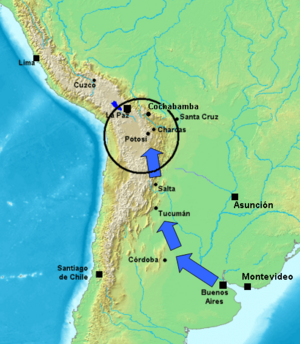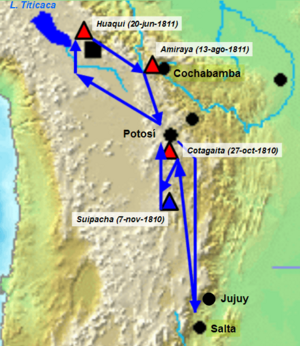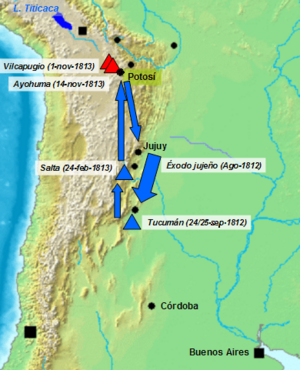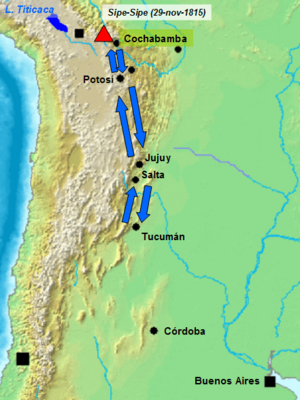Army of the North facts for kids

The Army of the North (known in Spanish as Ejército del Norte) was an important army during the Spanish American wars of independence. This army was created by the United Provinces of the Río de la Plata (which is now Argentina). Its main goal was to free the Northwest of Argentina and Upper Peru (which is now Bolivia) from the royalist troops of the Spanish Empire.
Many leaders commanded the Army of the North. Some of the most famous were Manuel Belgrano and José de San Martín. The army started its attacks in 1810. They stopped their main attacks in 1817. After that, they mostly defended the northern border. The main fight against the royalists then moved to the Army of the Andes, led by José de San Martín. He planned to reach Lima, the main royalist city, by going through Chile and across the Pacific Ocean.
In 1820, the Army of the North was called back to fight in a civil war. This was a conflict between the government in Buenos Aires and leaders from different provinces. However, many soldiers refused to fight in a civil war. They believed they should only fight for independence. This event, called the Arequito Revolt, led to the end of the Army of the North.
Later, during the War of the Confederation (1837-1839), a new army was also called the Army of the North. But this army did not fight in any major battles.
Contents
First Campaign to Upper Peru

The new revolutionary government in Buenos Aires faced a big problem. They did not have many trained soldiers. Most of their troops were militias, which are like citizen soldiers. Only a few groups had some experience. Until 1812, when experienced officers from the Napoleonic Wars arrived, the army was mostly made of these militias. Many of the early commanders were not military experts. They were chosen more for their political beliefs or their standing in society.
Forming the Army and Early Actions
The Army of the North began on June 14, 1810. The government in Buenos Aires ordered Juan José Castelli to gather troops. Their first mission was to fight Viceroy Santiago de Liniers. He was leading a group against the revolution in Córdoba.
The government started recruiting soldiers in Buenos Aires. They formed a small army of about 1,150 men. This force left Buenos Aires on July 6, 1810. Colonel Francisco Ortiz de Ocampo and Lieutenant Colonel Antonio González Balcarce led them. They marched towards Córdoba to face Liniers.
Like armies in the French Revolution, this army had a political leader. Hipólito Vieytes was the government's representative. He made sure the army followed the government's orders. He also had instructions to help provinces elect their own representatives to the new government.
The army was made up of different groups of soldiers. These included infantry (foot soldiers) and artillery (soldiers with cannons). They also had cavalry (soldiers on horseback). On August 8, 1810, the army arrived in Córdoba.
On July 31, the royalist leaders in Córdoba fled to Upper Peru. Liniers and other officers were captured on August 6. They were sent towards Buenos Aires. However, on August 26, the new political leader, Castelli, met them. Castelli ordered the punishment of Liniers and other leaders.
González Balcarce took over as the military commander. Juan José Castelli became the main political leader. With Córdoba now under their control, the army continued its march. They headed towards Upper Peru. Along the way, more towns joined the revolution. This helped Balcarce's army grow.
First Battles in Upper Peru
Balcarce began the march into Upper Peru with 400 men. The first battle for the Army of the North in Upper Peru was the Battle of Cotagaita. This happened on October 27. The battle was difficult for Balcarce's troops. They had to retreat south because the royalists had more soldiers.
On November 7, the armies met again at Suipacha. Here, the Argentine army won its first victory. Balcarce's army had fewer soldiers, but they still won. This victory gave them confidence to move further north. However, due to disagreements, Castelli had to dismiss Martín Miguel de Güemes and his gaucho soldiers.
The royalist defenses were led by General José Manuel de Goyeneche. He signed a truce with Castelli on May 16. The truce was supposed to last for forty days.
Defeat at Huaqui and Retreat
On June 20, 1811, Castelli broke the truce. He tried to surround the royalist troops. Goyeneche then ordered an attack. This led to the Battle of Huaqui. The rebel army had about 5,000 soldiers. But the royalists had 6,500 well-armed soldiers. The rebels suffered a big defeat.
After this battle, Goyeneche captured La Paz and Cochabamba. The remaining rebel soldiers were disorganized. They retreated south, first to Potosí, then to Jujuy, and finally to Salta. In Salta, Balcarce was replaced by Juan Martín de Pueyrredón.
The first campaign officially ended on March 26, 1812. Pueyrredón was replaced by General Manuel Belgrano. Balcarce and Castelli were blamed for the defeat. Castelli died before his trial ended. Balcarce was cleared and later rejoined the fight.
Second Expedition to Upper Peru
Belgrano Takes Command
In 1812, Manuel Belgrano became the new commander. The government decided to send a second expedition to Upper Peru. The goal was to finally defeat the royalist troops. They also wanted to boost the morale of the soldiers and the people.
On March 26, Belgrano took command. He immediately moved his troops to Jujuy Province, where he set up defenses. Belgrano's job was both political and military. He needed to restore morale and deal with royalist supporters in the area.
Belgrano's army was small, with about 1,500 men. Most were cavalry (soldiers on horseback). Only about 600 had guns. They also lacked bayonets and sabers. Belgrano spent his first months organizing the army. He set up a hospital and supply groups. He also worked to get ammunition and clothing made.
On July 1, 1812, Belgrano created the 8th Infantry Regiment. This regiment was made of men from Upper Peru. However, it was disbanded after a defeat later on. Belgrano also found spies in Salta who were helping the royalist army. He forced the city's bishop, who was leading the spies, to leave.
Belgrano decided to move towards Cochabamba. His advanced troops reached Humahuaca. The rest of the army stayed in Jujuy. In Jujuy, he celebrated the second anniversary of the May Revolution. He also had a new white and light blue flag blessed. This ceremony helped gain support from the local people.
Jujuy's Exodus and Victories
Belgrano received orders to retreat towards Córdoba. He decided to leave nothing for the enemy to use. This event is known as the Jujuy Exodus. He ordered everyone to leave the city with the army. They also burned everything behind them. This made it harder for the enemy to advance.
On September 3, the army met the enemy. Belgrano used his new artillery and defeated the royalists. Ten days later, they camped in Tucumán. They decided to stop retreating there. On September 24, they fought the Battle of Tucumán. A strong cavalry charge gave the rebels a big victory. The patriots had 1,800 men and defeated 3,000 royalists. The royalists lost many soldiers and supplies. This forced them to retreat north to Salta.
The victory at Tucumán gave Belgrano four months to reorganize his army. He doubled the number of men and improved their training. He also received more soldiers from Buenos Aires.
Well-equipped and with high morale, they marched north to Salta on January 12. A month later, on the Juramento river, the troops swore loyalty to the Constitutional Assembly and the new flag. With local help, they found a hidden road. This allowed them to attack the royalists from behind on February 20. The independentist victory at the Battle of Salta was decisive. The royalist commander, Tristán, surrendered. Belgrano's army had 3,700 men and defeated 3,700 royalists. Belgrano took all their weapons and supplies. This greatly improved his army's situation.
Second Upper Peru Campaign and Retreat
Belgrano continued his march north. He took Potosí on June 21. He then reached Vilcapugio on September 27. He waited for more soldiers there. Belgrano negotiated a 40-day truce with the royalist general, Joaquín de la Pezuela. However, the royalists attacked by surprise, ignoring the agreement. This led to the Battle of Vilcapugio on October 1, 1813.
The royalist army had 4,000 men. The patriot army had 3,500 men. The battle started well for the rebels, but they were eventually defeated. They retreated to Macha. Belgrano then marched to Ayohuma.
Five days later, on November 14, the royalist army arrived to fight the Battle of Ayohuma. The rebel army had 2,000 men ready to fight. The royalists had a stronger army with 3,500 men. The battle was very tough for both sides. The rebels were defeated. As a result, Upper Peru returned to royalist control. Belgrano returned to Jujuy.
In January 1814, José de San Martín replaced Manuel Belgrano as commander. Belgrano returned to Buenos Aires. San Martín left four months later due to health reasons. He was replaced by José Rondeau.
The goals of this campaign were partly met. The royalist army was not completely defeated. But the rebels stopped their advance into northern Argentina. This kept the revolution going.
Third Auxiliary Campaign to Upper Peru
After defending northern Argentina for a year, the Army of the North received new orders. They were to start a third campaign into Upper Peru. This time, the goal was to take control of all of Upper Peru. This would stop the royalists from attacking. Then, they planned to continue to Lima to free the capital of the Viceroyalty of Peru.
Mutiny and New Advance
While preparing for the third campaign, General Carlos María de Alvear was named to replace Rondeau. However, the army's officers refused to accept Alvear. They told Rondeau they would only follow his orders. They asked him to start the campaign. Rondeau agreed, and the operation began in January 1815. For the first ten months, there were small fights.
On February 19, they fought the battle of El Tejar. The rebel advance group was surprised by the entire royalist army. Colonel Martín Rodríguez was captured. He was later freed in a prisoner exchange.
In April, the army stopped at Puesto del Marqués. This small village was held by royalist forces. General Rondeau attacked with 500 men and defeated the 300 defenders.
As they moved into Upper Peru, a scouting group found royalist troops. They planned a surprise attack, but it failed. The royalists escaped. General Joaquín de la Pezuela, the royalist commander, moved his forces back. Rondeau's forces then took control of Potosí and Charcas.
Meanwhile, Martín Miguel de Güemes was unhappy with Rondeau. He left the army with his gaucho forces. He returned to Salta, taking many supplies with him.
Defeat at Sipe-Sipe and Retreat
The only major battle of this campaign happened on November 29, 1815. The patriot army was near Cochabamba. They met the royalist army led by General Pezuela. They fought the Battle of Sipe-Sipe. The rebels were defeated. They had 3,500 men and 9 cannons. The royalists had 5,100 men and 23 cannons. The rebels had to escape, losing about 1,000 soldiers.
The campaign's goals were not met. The provinces were still surrounded by possible enemies. British and French forces could arrive by sea. Portuguese forces could come from the East. And Spanish forces were still in the North. If they had conquered Upper Peru, the biggest threat from the royalists would have ended.
In January 1816, Lieutenant Colonel Gregorio Aráoz de Lamadrid was sent north. But he was defeated on January 31. Rondeau received an order to retreat to Tucumán. The army, almost defeated, marched for nine months. They went through Potosí and Humahuaca. They finally reached Tucumán. On August 7, 1816, Manuel Belgrano replaced Rondeau again. Martín Miguel de Güemes was named commander of the northern border.
Belgrano moved the army to a fort built by San Martín in Tucumán. There, he tried to rebuild the army's morale and supplies. He hoped to combine actions with San Martín's army in the Andes.
Fourth Campaign and Gaucho War
The fourth campaign was the last attempt to free Upper Peru. Belgrano sent troops to help the resistance in Oruro. During this time, the army also got involved in internal conflicts.
On December 10, 1816, Belgrano sent La Madrid to stop a movement in Santiago del Estero. La Madrid defeated the troops of Juan Francisco Borges. On January 1, 1817, Borges was punished by order of the Tucumán Congress.
On March 18, 1817, 400 soldiers left Tucumán. General La Madrid led them towards Oruro. Once in Upper Peru, local rebels joined them. These rebels helped stop royalist reinforcements. On April 15, 1817, the rebels won the Battle of la Tablada de Tolomosa. They took control of Tarija. This victory gave the Army of the North many weapons, ammunition, and supplies. Over a thousand new volunteers also joined the army. La Madrid stayed in Tarija until May 5, 1817. He then marched towards Chuquisaca. La Madrid attacked Chuquisaca on May 21, but his forces were pushed back. On June 12, the army was surprised at Sopachuy and defeated. They had to retreat to Salta.
Last Royalist Invasion and Güemes's Death
In August 1817, Colonel Olañeta launched a new attack with 1,000 men. On August 15, they fought at Humahuaca. On September 12, they fought at Huacalera. On January 3, 1818, the royalists retreated to Upper Peru. Later, Olañeta and Colonel José María Valdez invaded again with 2,400 men. On January 14, they took Jujuy. But they had to leave on January 16 and returned to Yavi.
On February 1, 1820, the Army of the North received orders to leave Tucumán. They were to go to Buenos Aires to fight against local uprisings. The defense of the northwest was left to the gaucho soldiers of Martín Miguel de Güemes.
In February 1820, Juan Ramírez Orozco became the commander of the Royalist forces in Upper Peru. On May 12, Orozco led 4,000 men to Jujuy. On May 28, he took the city. Then, on May 31, he occupied Salta. On June 2, the royalist forces defeated the patriots at Chamical. But later, the patriots won battles at Las Cañas and Cuesta de la Pedrera. This forced the royalists to retreat to Jujuy.
On April 27, 1821, General José Ignacio Gorriti defeated 400 royalists at León. This forced Olañeta to withdraw his forces. On June 7, Colonel José María Valdés led 600 soldiers from Yavi. They surprised Salta, where Martín Miguel de Güemes was wounded. Güemes died on June 17, 1821. Colonel José Enrique Vidt took command of Güemes's army. On June 22, Olañeta took Jujuy and advanced to Salta. But finding himself surrounded, he signed a truce on July 14 and returned to Upper Peru.
Olañeta made his last attack into Argentine territory in June 1822. He reached Volcán. On December 6, 1822, he left Argentina for the last time. This ended the royalist invasions.
On August 4, 1824, the governor of Salta, General Juan Antonio Álvarez de Arenales, ordered General José María Pérez de Urdininea to go to Upper Peru. He was to attack Olañeta from the south. In March 1825, Álvarez de Arenales started another campaign. But he received news that Lieutenant Colonel Carlos Medinaceli had joined the independentist cause. So, he sent Pérez de Urdininea to support Medinaceli. On April 1, 1825, they fought at Tumusla. Medinaceli defeated Olañeta, finally freeing Upper Peru.
Commanders
- Hipólito Vieytes (June 14, 1810 – August 1810) Political command
- Francisco Ortiz de Ocampo (June 14, 1810 – August 1810) Military commander
- Juan José Castelli (August 1810 – June 1811) Political command
- Antonio González Balcarce (August 1810 – June 1811) Military commander
- Juan Martín de Pueyrredón (June 1811 – March 26, 1812)
- Manuel Belgrano (March 26, 1812 – January 30, 1814)
- José de San Martín (January 30, 1814 – May 1814)
- José Rondeau (May 1814 – August 7, 1816)
- Carlos María de Alvear (appointed January 1815, but did not take command)
- Manuel Belgrano (August 7, 1816 – November 11, 1819)
- Francisco Fernández de la Cruz (November 11, 1819 – January 8, 1820)
Component units of the Army of the North
July–August 1810
- 1st and 2nd Regiments of Patrician Infantry
- 3rd Infantry Regiment "Arribenos"
- 4th Mountain Infantry Regiment
- 5th Infantry Regiment "Andaluces"
- Pardos and Morenos Regiments
- Representative Company, Buenos Aires Regt.
- Artillery Group
- Blandengues Cavalry Battalion
- Hussar Troop
- Dragoon Troop
November–December 1810
- 1st and 2nd Regiments of Patrician Infantry
- 6th Regiment of Foot Infantry
- Fatherland (Peruvian) Light Dragoons Regiment
- 7th Regiment of Infantry "Cochabamba"
- Salta Division
March 1812
- Artillery Group
- 6th (Peruvian) Infantry Regiment
- Pardos and Morenos Regiment
- Fatherland Hussars and Dragoons
- Peru Light Dragoons
See also
 In Spanish: Ejército del Norte (Provincias Unidas del Río de la Plata) para niños
In Spanish: Ejército del Norte (Provincias Unidas del Río de la Plata) para niños




